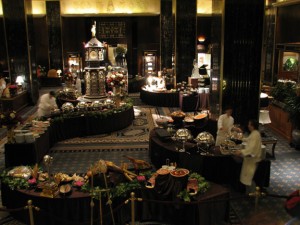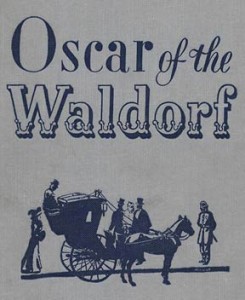Oscar the Magician, Maitre d’Hotel of the Waldorf-Astoria
July 18, 2011
I love stumbling across historical gems — here’s one from The Sphinx magazine (a well-known magazine for magicians) that ties together two of my loves: magic and the Waldorf-Astoria hotel. This hotel, now located on Park Avenue, was previously located at the corner of 34th Street and Fifth Avenue, but was torn down in 1929 to make room for the Empire State Building.
Editor William Hilliar reported this closing in the May 1929 issue, and wrote about one of the Waldorf’s most famous employees, Oscar Tschirky. If you’ve been to my Chamber Magic show, you know that I summon the ghost of Oscar nightly to assist with a magic trick. It turns out he was actually a bit of a magician himself, as you’ll see below.
Here is the text I found:
[The Sphinx, May 1929, p. 108:]
The Hotel Waldorf-Astoria has closed its doors and they have begun to dismantle it. There will be a new one built in two years on a different site and the famous Oscar will again manage it. Comparatively few of the magicians know that Oscar has always been a most interested amateur magician, but I have it on very good authority – he told me himself.
Here is a photo of Oscar’s cocktail book, 100 Famous Cocktails. I own a copy of this rare book (thanks to a Chamber Magic customer who sent it to me as a present).
Oscar is believed to have invented the Waldorf Salad, Veal Oscar, chicken pot pie, and to have popularized 1000 Island Dressing and Red Velvet Cake. We have a lot to thank him for!
You can enjoy some of Oscar’s signature dishes, and many more contemporary delights at the Waldorf-Astoria’s magnificent Sunday brunch. It takes place in the hotel lobby, directly in front of Peacock Alley restaurant. You should put this on your “list” of must-visit restaurants – it’s really something special.
Here is an excerpt from “100 Famous Cocktails” that I’m taking the time to type up, for fear that these words might get lost if not recorded online. Oscar’s book is so rare that the following “Waldorf Bar History” chapter may be forgotten forever. So, without further adieu, here are pages 20 and 21 from “100 Famous Cocktails”.
The old Waldorf-Astoria, razed a few years ago to make way for the Empire State Building, was unquestionably the most famous hostelry in the United States, possibly in the entire world. Visiting royalty, wearers of coronets, diplomatists and other persons of distinction from abroad were ordinarily entertained there. And commoners of our own land who had attained prominence paced its Peacock Alley daily.
Yet the building in which all of these events centered has passed and a mightier skyscraper stands in its place, while in the newer residential district on fashionable Park Avenue another Waldorf-Astoria has reared its twin towers into the skyline. All this seems the more remarkable when one realizes that one hundred years ago the site of the original Waldorf building was a small field on one of the prettiest farms of Manhattan Island. A brook babbled across the property and an occasional wagon rumbled on the dusty Bloomingdale Road.
The roster of the old Bar’s patrons would seem almost the record of a period in American life, J. Pierpont Morgan, the elder, used to call for a Manhattan cocktail after the market closed. Senator Marcus Alonzo Hanna, power behind the throne in the McKinley administration, called when in New York. Samuel Langhorne Clemens, better known as Mark Twain, was an occasional visitor, accompanied by his friend H. H. Rogers, of the Standard Oil Company.
Colonel William F. Cody, otherwise “Buffalo Bill”; Vice President Charles Warren Fairbanks; Senator Matthew Stanley Quay, the iron boss of Pennsylvania; Alfred E. Smith, Sheriff, Governor and candidate for the Presidency; John W. Gates, always ready to “bet you a million”; General Nelson A. Miles; Diamond Jim Brady; Richard Croker and Charley Murphy of Tammany Hall — there were always numerous celebrities at the Bar, or leaving, or shortly to come.
Actors rubbed elbows with financiers and athletes with industrial giants. Richard Harding David, author and war correspondent, came occasionally, as did John McGraw of the baseball fame. There were noted prize fighters — John L. Sullivan, Jim Jeffries, Tom Sharkey and “Gentleman Jim” Corbett. Many, including Nat Goodwin, Peter Dailey and W.H. Crane, represented the stage. Great publishers and editors, including Colonel (“Marse Henry”) Watterson, visited the Waldorf Bar.
But a list of prominent patrons would read like many pages from “Who’s Who in America” and space forbids. The point is that the Bar attracted these men of fastidious tastes because its drinks were what they ought to be. Numerous formulas were created there — to meet the challenges of guests.
A number of drinks dispensed at the Old Waldorf Bar and new drinks originated at the new Waldorf Bar — “Lounge Cafe”, will be found on the following pages.
May they gladden many a heart!


